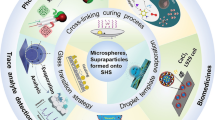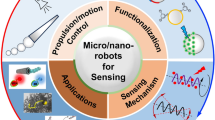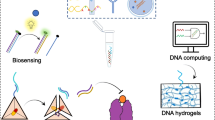Abstract
Microrobots have many potential uses in microbiology since they can be remotely actuated and precisely manipulated in biochemical fluids. Cellular function and response depends on biochemicals. Therefore, various delivery methods have been developed for delivering biologically relevant cargo using microrobots. However, localized targeting without payload leakage during transport is challenging. Here, we design a microrobotic platform capable of on-demand delivery of signaling molecules in biological systems. The on-demand delivery method is based on a light-responsive photolabile linker which releases a cell-to-cell signaling molecule when exposed to light, integrated on the surface of microrobots. Successful delivery of the signaling molecules and subsequent gene regulation is also demonstrated. This proposed method can be used for multiple applications, especially in biology, engineering, and medicine where on-demand delivery of chemical cargo at targeted locations is important.











Similar content being viewed by others
Notes
This paper is an invited extended version of [7] from the MARSS conference. The synthesis of the photocleavable linker, integration of the cylindrical microrobots with the linker, and protein expression in bacterial cells are the same as that paper, while we have added further data on the dose response of the signaling molecule in the cells. We have also demonstrated cellular response using directed microrobots and extended the microrobot type to helical microrobots, which will be used for further extension of the work in the future.
References
Ricotti L, Trimmer B, Feinberg AW, Raman R, Parker KK, Bashir R, Sitti M, Martel S, Dario P, Menciassi A (2017) Biohybrid actuators for robotics: A review of devices actuated by living cells. Sci Robot 2(12):495
Peyer KE, Zhang L, Nelson BJ (2013) Bio-inspired magnetic swimming microrobots for biomedical applications. Nanoscale 5:1259–1272
Hunter EE, Brink EW, Steager EB, Kumar V (2018) Toward soft micro bio robots for cellular and chemical delivery. IEEE Robot Automation Lett 3(3):1592–1599
Yim S, Goyal K, Sitti M (2013) Magnetically actuated soft capsule with the multimodal drug release function. IEEE/ASME Trans Mechatron 18(4):1413–1418
Wang H, Huang Q, Shi Q, Yue T, Chen S, Nakajima M, Takeuchi M, Fukuda T (2015) Automated assembly of vascular-like microtube with repetitive single-step contact manipulation. IEEE Trans Biomed Eng 62(11):2620–2628
Bainton NJ, Bycroft BW, Chhabra SR, Stead P, Gledhill L, Hill P J, Rees CE, Winson MK, Salmond GP, Stewart GS, Williams P (1992) A general role for the lux autoinducer in bacterial cell signalling: control of antibiotic biosynthesis in erwinia. Gene 116(1):87–91
Das S, Hunter EE, DeLateur NA, Steager EB, Weiss R, Kumar V (2018) Controlled delivery of signaling molecules using magnetic microrobots. In: 2018 international conference on manipulation, automation and robotics at small scales (MARSS), pp 1–5
Fusco S, Ullrich F, Pokki J, Chatzipirpiridis G, Ozkale B, Sivaraman K, Ergeneman O, Pané S, Nelson B (2014) Microrobots: A new era in ocular drug delivery. Expert Opin Drug Deliv 11:1–12, 07
Ceylan H, Giltinan J, Kozielski K, Sitti M (2017) Mobile microrobots for bioengineering applications. Lab Chip 17:1705– 1724
Xu T, Yu J, Yan X, Choi H, Zhang L (2015) Magnetic actuation based motion control for microrobots: An overview. Micromachines 6(9):1346–1364
Yang Y, Mu J, Xing B (2017) Photoactivated drug delivery and bioimaging. Wiley Interdisciplinary Reviews: Nanomedicine and Nanobiotechnology 9(2):n/a–n/a
Bozuyuk U, Yasa O, Yasa IC, Ceylan H, Kizilel S, Sitti M (2018) Light-triggered drug release from 3d-printed magnetic chitosan microswimmers. ACS Nano 12(9):9617–9625. pMID: 30203963
Qiu F, Fujita S, Mhanna R, Zhang L, Simona BR, Nelson BJ (2015) Magnetic helical microswimmers functionalized with lipoplexes for targeted gene delivery. Adv Funct Mater 25(11):1666–1671
Pearson J, Pesci E, Iglewski B (1997) Roles of pseudomonas aeruginosa las and rhl quorum-sensing systems in control of elastase and rhamnolipid biosynthesis genes. J Bacteriol 179(18): 5756–5767
Erkoc P, Yasa IC, Ceylan H, Yasa O, Alapan Y, Sitti M (2018) Mobile microrobots for active therapeutic delivery. Adv Ther 2(1):1800064
Ceylan H, Giltinan J, Kozielski K, Sitti M (2017) Mobile microrobots for bioengineering applications. Lab Chip 17(10):1705–1724
Tottori S, Zhang L, Qiu F, Krawczyk KK, Franco-Obregon A, Nelson BJ (2012) Magnetic helical micromachines: Fabrication, controlled swimming, and cargo transport. Adv Mater 24(6):811– 816
Das S, Steager EB, Stebe KJ, Kumar V (2017) Simultaneous control of spherical microrobots using catalytic and magnetic actuation. In: 2017 International Conference on Manipulation, Automation and Robotics at Small Scales (MARSS), pp 1–6
Das S, Steager EB, Hsieh MA, Stebe KJ, Kumar V (2018) Experiments and open-loop control of multiple catalytic microrobots. J Micro-Bio Robot 14(1):25–34
Weber E, Engler C, Gruetzner R, Werner S, Marillonnet S (2011) A modular cloning system for standardized assembly of multigene constructs. PLoS ONE 6(2):e16765
Karig D, Martini KM, Lu T, DeLateur NA, Goldenfeld N, Weiss R (2018) Stochastic Turing patterns in a synthetic bacterial population. Proc Natl Acad Sci 115(26):6572–6577
Klan P, Solomek T, Bochet CG, Blanc A, Givens R, Rubina M, Popik V, Kostikov A, Wirz J (2013) Photoremovable protecting groups in chemistry and biology: Reaction mechanisms and efficacy. Chem Rev 113(1):119–191. pMID: 23256727
Neises B, Steglich W (1978) Simple method for the esterification of carboxylic acids. Angew Chem Int Ed Engl 17(7):522–524
Coon CL, Blucher WG, Hill ME (1973) Aromatic nitration with nitric acid and trifluoromethanesulfonic acid. J Org Chem 38(25):4243–4248
Suhs T, Konig B (2006) Synthesis of functionalized guanidino amino acids. Chem Eur J 12(31):8150–8157
Tang S, Wang J, Zhu Q, Chen Y, Li X (2014) Preparation of rutile tio2 coating by thermal chemical vapor deposition for anticoking applications. ACS Appl Mater Interfaces 6(19):17157–17165. pMID: 25192018. [Online]. Available: https://doi.org/10.1021/am5048762
Paz Y (2011) Self-assembled monolayers and titanium dioxide: From surface patterning to potential applications. Beilstein J Nanotechnol 2:845–861
Thomas AG, Syres KL (2012) Adsorption of organic molecules on rutile tio2 and anatase tio2 single crystal surfaces. Chem Soc Rev 41:4207–4217. https://doi.org/10.1039/C2CS35057B
Pesci EC, Pearson JP, Seed PC, Iglewski BH (1997) Regulation of las and rhl quorum sensing in pseudomonas aeruginosa. J Bacteriol 179(10):3127–3132
Loeschcke A, Binder D, Drepper T, Jaeger K-E, Grünberger A, Probst C, Kohlheyer D, Wiechert W, Pietruszka J, Bier C (2014) Light-responsive control of bacterial gene expression: precise triggering of the lac promoter activity using photocaged IPTG. Integr Biol 6(8):755–765, 06. https://doi.org/10.1039/c4ib00027g
Steager EB, Wong D, Chodosh N, Kumar V (2015) 2015 IEEE international conference on robotics and automation (ICRA)
Il’ichev YV, Schworer MA, Wirz J (2004) Photochemical reaction mechanisms of 2-nitrobenzyl compounds: Methyl ethers and caged atp. J Am Chem Soc 126(14):4581–4595. pMID: 15070376
Abbott JJ, Peyer KE, Lagomarsino MC, Zhang L, Dong L, Kaliakatsos IK, Nelson BJ (2009) How should microrobots swim? Int J Robot Res 28(11-12):1434–1447
Acknowledgments
We gratefully acknowledge the support of ONR grant N00014-11-1-0725, NSF grant CNS-1446474 and NSF grant CNS-1446592. E.E.H. was supported by NSF Graduate Research Fellowship grant DGE-1845298
Author information
Authors and Affiliations
Corresponding author
Additional information
Publisher’s note
Springer Nature remains neutral with regard to jurisdictional claims in published maps and institutional affiliations.
Electronic supplementary material
Below is the link to the electronic supplementary material.
(AVI 9.30 MB)
(AVI 13.1 MB)
Rights and permissions
About this article
Cite this article
Das, S., Hunter, E.E., DeLateur, N.A. et al. Cellular expression through morphogen delivery by light activated magnetic microrobots. J Micro-Bio Robot 15, 79–90 (2019). https://doi.org/10.1007/s12213-019-00119-x
Received:
Revised:
Accepted:
Published:
Issue Date:
DOI: https://doi.org/10.1007/s12213-019-00119-x




